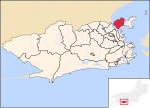Rio de Janeiro/Galeão International Airport

Rio de Janeiro/Galeão–Antonio Carlos Jobim International Airport (IATA: GIG, ICAO: SBGL), popularly known by its original name Galeão International Airport, is the main airport serving Rio de Janeiro, Brazil. The airport was originally named after the neighborhood of Galeão: Praia do Galeão (Galleon Beach) is located in front of the original passenger terminal (the present passenger terminal of the Brazilian Air Force). This beach is the location where the galleon Padre Eterno was built in 1663. On January 5, 1999 the name was changed adding a tribute to the Brazilian musician Antonio Carlos Jobim. Galeão Airport is explicitly mentioned in his composition Samba do Avião. Since August 12, 2014 the airport has been operated by the concessionary Rio Galeão, a consortium formed by the Brazilian investor Odebrecht and Changi Airport Group, with a minority participation of the government owned company Infraero, the previous operator. The new concessionary has been using the brand name RIOgaleão–Aeroporto Internacional Tom Jobim.Some of its facilities are shared with the Galeão Air Force Base of the Brazilian Air Force.
Excerpt from the Wikipedia article Rio de Janeiro/Galeão International Airport (License: CC BY-SA 3.0, Authors, Images).Rio de Janeiro/Galeão International Airport
Avenida Vinte de Janeiro, Rio de Janeiro Galeão
Geographical coordinates (GPS) Address Nearby Places Show on map
Geographical coordinates (GPS)
| Latitude | Longitude |
|---|---|
| N -22.81 ° | E -43.250555555556 ° |
Address
Avenida Vinte de Janeiro
Avenida Vinte de Janeiro
21942-900 Rio de Janeiro, Galeão
Rio de Janeiro, Brazil
Open on Google Maps




